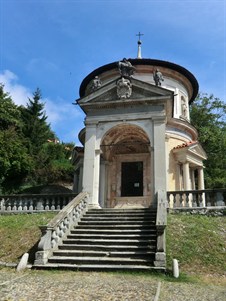Varallo and Varese
 The Sacro Monte of Varallo is the oldest example, and probably has the greatest artistic value, among the Sacri Monti of Piedmont and Lombardy. Construction work began in the late fifteenth century, on a beautiful cliff that overlooked the town of Varallo, according to the project of the Franciscan friar Bernardino Caimi. The idea was to create a New Jerusalem, which would evoke, even in the physical conformation of the places and in the form of buildings, the experience of pilgrimage to the Holy Land. The work continued even after the death of Father Caimi and was entrusted to the guidance in the following decades, of the sculptor and architect Gaudenzio Ferrari, some of his students and then, in the sixties of the sixteenth century, to the architect Galeazzo Alessi. This changed the overall design of the structure, renouncing the idea of a reconstruction of the life and passion of Christ (through the places of Nazareth, Bethlehem and Jerusalem), in favour of a chronological narrative. Carlo Borromeo and the dukes of the House of Savoy became personally interested in the structure, which then underwent several changes during the seventeenth century, the period from which the construction of the Basilica dell’Assunta (Basilica of the Assumption) dates. Nowadays, the Sacro Monte of Varallo is composed of the Basilica and 45 frescoed chapels which house more than 800 statues of life-size polychrome terracotta.
The Sacro Monte of Varallo is the oldest example, and probably has the greatest artistic value, among the Sacri Monti of Piedmont and Lombardy. Construction work began in the late fifteenth century, on a beautiful cliff that overlooked the town of Varallo, according to the project of the Franciscan friar Bernardino Caimi. The idea was to create a New Jerusalem, which would evoke, even in the physical conformation of the places and in the form of buildings, the experience of pilgrimage to the Holy Land. The work continued even after the death of Father Caimi and was entrusted to the guidance in the following decades, of the sculptor and architect Gaudenzio Ferrari, some of his students and then, in the sixties of the sixteenth century, to the architect Galeazzo Alessi. This changed the overall design of the structure, renouncing the idea of a reconstruction of the life and passion of Christ (through the places of Nazareth, Bethlehem and Jerusalem), in favour of a chronological narrative. Carlo Borromeo and the dukes of the House of Savoy became personally interested in the structure, which then underwent several changes during the seventeenth century, the period from which the construction of the Basilica dell’Assunta (Basilica of the Assumption) dates. Nowadays, the Sacro Monte of Varallo is composed of the Basilica and 45 frescoed chapels which house more than 800 statues of life-size polychrome terracotta.
 Varallo served as a model for other Sacri Monti made during the sixteenth and seventeenth century within the borders of the Duchy of Milan. The construction of the Sacro Monte of Varese (photo: chapel VII) began in 1604, around the Sanctuary of Santa Maria del Monte (Holy Mary of the Mountain), a place of pilgrimage since the Middle Ages. Thirteen chapels were finished already in 1623 thanks to the generosity of the donations of the faithful, and under the direction of Giuseppe BernasconiGiuseppe Bernasconi (or Bernascone), called the Left, was an architect of Varese. Born in the city of Lombardy around 1560, died in 1625 or shortly thereafter. His most important work was the church of the Immaculate Conception, always in Varese, built under the patronage of Cardinal Federico Borromeo.. The entire structure, the realization of which Cardinal Federico Borromeo became personally involved with, was completed by the end of the seventeenth century. The 14 chapels, dedicated to the mysteries of the Rosary, lead to the sanctuary of Santa Maria del Monte, who serves as the fifteenth chapel. Divided in groups of five, as in the rosary, the chapels are separated by triumphal arches and spectacular fountains. It is in Mannerist style and designed for the refreshment of the pilgrim. Inside the chapels, frescoes and statues in polychrome terracotta are an excellent example of religious art of the seventeenth century Milan.
Varallo served as a model for other Sacri Monti made during the sixteenth and seventeenth century within the borders of the Duchy of Milan. The construction of the Sacro Monte of Varese (photo: chapel VII) began in 1604, around the Sanctuary of Santa Maria del Monte (Holy Mary of the Mountain), a place of pilgrimage since the Middle Ages. Thirteen chapels were finished already in 1623 thanks to the generosity of the donations of the faithful, and under the direction of Giuseppe BernasconiGiuseppe Bernasconi (or Bernascone), called the Left, was an architect of Varese. Born in the city of Lombardy around 1560, died in 1625 or shortly thereafter. His most important work was the church of the Immaculate Conception, always in Varese, built under the patronage of Cardinal Federico Borromeo.. The entire structure, the realization of which Cardinal Federico Borromeo became personally involved with, was completed by the end of the seventeenth century. The 14 chapels, dedicated to the mysteries of the Rosary, lead to the sanctuary of Santa Maria del Monte, who serves as the fifteenth chapel. Divided in groups of five, as in the rosary, the chapels are separated by triumphal arches and spectacular fountains. It is in Mannerist style and designed for the refreshment of the pilgrim. Inside the chapels, frescoes and statues in polychrome terracotta are an excellent example of religious art of the seventeenth century Milan.
